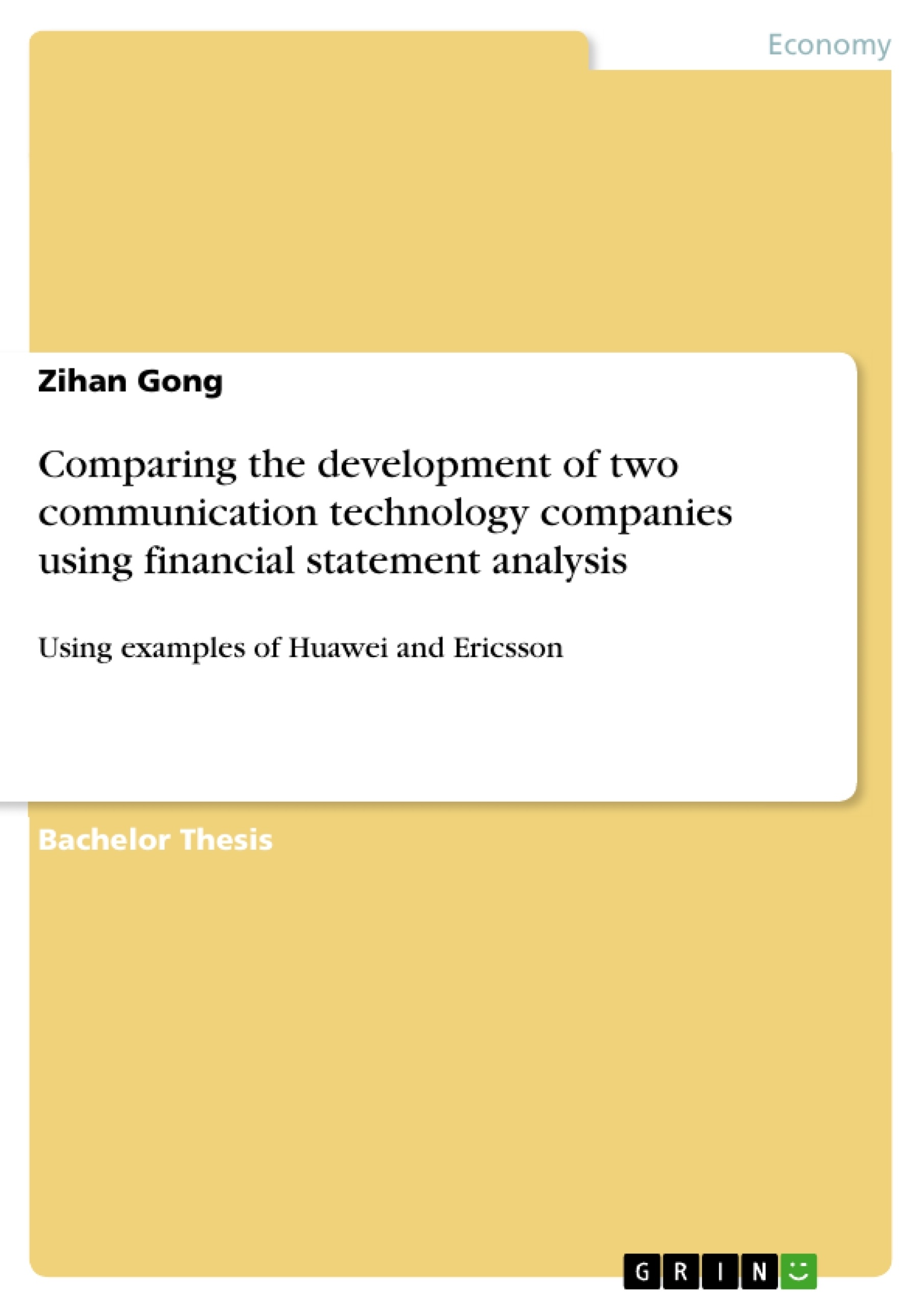The general aim of this present thesis is to gain insight into the economic situationof both companies from published annual reports and then into the development of Huawei and Ericsson within six years, since other sources of financial data are not available to outsiders, and the analysis of the consolidated financialstatements of Huawei and Ericsson, which was prepared in accordance with IFRSs, within the six year period, gives insights into the economic situation of the two companies. To be more precise, the objectives of this essay are to analyze the financial statements of those two communication technology companies using various financial indicators in order to evaluate both balance sheets’ structures, liquidity situations and performances, then to perform a comparison between those two companies in order to study the development of both companies during the last six years and to find out how Huawei overtook its rival Ericsson and whether this success and continuous growth is still sustainable in the current global economic recession and financial crisis as well as in the future.
This thesis’s main task is to compare the analytic results of the two firms from 2011 to 2016 in order to find out to what extent Huawei has surpassed Ericsson, using the instruments of financial statement analysis. First, using the principle of Küting and Weber, we reformulated the financial statements of the two companies to make them more comparable, and then we calculated the necessary key ratios extracted from annual financial reporting so that we can make comparison and outline the company’s status in three aspects, i.e. structure, liquidity, and performance. At last, after comparison of ratios of the two companies conclusions were drawn.
Inhaltsverzeichnis (Table of Contents)
- 1. Introduction
- 1.1 Background and objectives of thesis
- 1.2 Tasks of thesis
- 1.3 Outline of thesis
- 2. Fundamentals of the concept of financial statement analysis
- 2.1 Definition
- 2.2 Objectives and functions
- 2.3 Procedure
- 2.4 Analysis areas and limitation
- 3. Comparison of companies
- 3.1 Huawei
- 3.1.1 Company profile
- 3.1.2 Accounting policies and changes
- 3.2 Ericsson
- 3.2.1 Company profile
- 3.2.2 Accounting policies and changes
- 4. Quantitative Evaluation
- 4.1 Reformulation of financial statement
- 4.1.1 Standard balance sheet
- 4.1.2 Reclassification of comprehensive income statement
- 4.2 Structure analysis
- 4.2.1 Asset side
- 4.2.2 Liability side
- 4.3 Liquidity analysis
- 4.3.1 Maturity matching analysis
- 4.3.2 Cash flow analysis
- 4.4 Performance analysis
- 4.4.1 Income structure analysis
- 4.4.2 Expenses structure analysis
- 4.4.3 Profitability analysis
- 5. Comparison of results
- 5.1 Asset situation
- 5.2 Financial situation
- 5.3 Profit situation
Zielsetzung und Themenschwerpunkte (Objectives and Key Themes)
This thesis aims to compare the development of two communication technology companies, Huawei and Ericsson, using financial statement analysis. The study utilizes a comprehensive approach, analyzing both the quantitative and qualitative aspects of the companies' performance. The main objective is to identify similarities and differences in their financial strategies and growth trajectories. Key themes explored in the thesis include:- Financial statement analysis as a tool for evaluating company performance.
- Comparison of accounting policies and practices in different jurisdictions.
- Assessment of liquidity and profitability ratios in the context of the telecommunications industry.
- Analysis of asset and financial structures of the two companies.
- Identification of key factors influencing the financial development of communication technology companies.
Zusammenfassung der Kapitel (Chapter Summaries)
Chapter 1 provides an introduction to the thesis, outlining the background, objectives, and tasks involved. It also presents a brief overview of the chosen companies and the chosen approach for their comparative analysis. Chapter 2 delves into the fundamentals of financial statement analysis, covering its definition, objectives, functions, procedures, and key analysis areas. The chapter also discusses the limitations of financial statement analysis and the importance of considering both quantitative and qualitative data. Chapter 3 introduces the two companies chosen for the study, Huawei and Ericsson. The chapter provides a detailed company profile for each, including their business model, key products and services, and relevant industry context. It also discusses their respective accounting policies and any significant changes that have occurred over time. Chapter 4 presents a quantitative evaluation of the financial performance of both companies. This chapter focuses on reformulating financial statements to ensure comparability, performing structure and liquidity analyses, and assessing profitability ratios. Chapter 5 offers a comparative analysis of the results obtained from the quantitative evaluation in Chapter 4. The chapter focuses on comparing the asset situation, financial situation, and profitability of Huawei and Ericsson.Schlüsselwörter (Keywords)
This thesis explores the financial development of communication technology companies, particularly Huawei and Ericsson. The study employs financial statement analysis, which is a comprehensive tool for evaluating company performance. Key focus areas include quantitative evaluation, reformulation of financial statements, structure analysis, liquidity analysis, performance analysis, and comparison of results. The thesis aims to provide insights into the financial strategies, growth trajectories, and key success factors for communication technology companies in a globalized and competitive market.- Arbeit zitieren
- Zihan Gong (Autor:in), 2017, Comparing the development of two communication technology companies using financial statement analysis, München, GRIN Verlag, https://www.grin.com/document/377962



